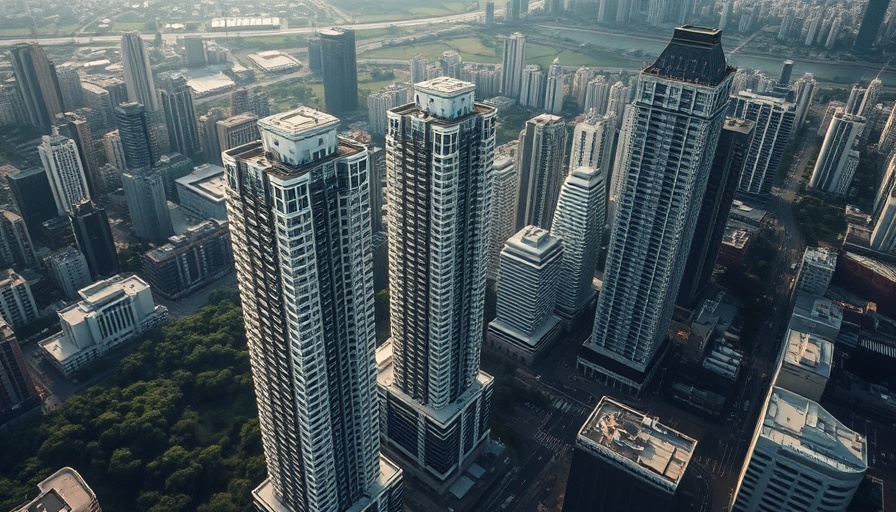
Understanding South Korea's Housing Preference
In South Korea, apartments reign as the preferred form of housing, a stark contrast to the American aspiration for single-family homes. For many South Koreans, like IT specialist Lee Chang-hee, living in a sizable apartment complex represents stability and community. Lee describes his residence as a small, yet vibrant world where amenities foster interaction and connection among neighbors. This sense of community stands in contrasts to perceptions of solitary living prevalent in US suburbs, where individual houses often dominate the landscape.
Unlike in cities like Los Angeles, where approximately 75% of residential land allows only for single-family housing, South Korea has embraced multifamily living. This choice is not merely a matter of preference but an answer to urban population pressures. Currently, 64% of South Korean households live in apartment complexes, demonstrating a tuple of efficient space usage and community-focused design—elements that are becoming increasingly relevant as urban centers globally grapple with severe housing shortages.
The Urban Planning Divide: America vs. South Korea
The urban planning philosophies between the two countries illustrate a fundamental difference in societal values concerning housing. In South Korea, the preference for apartments emerged through decades of targeted housing policy that prioritized convenient, high-density living environments. Housing policies in the 1960s ensured that the population could thrive in relatively small spaces, leveraging the benefits of proximity to essential services such as schools, parks, and public transportation.
In contrast, cities like Los Angeles are struggling with rapid population growth due to stringent zoning laws that restrict high-density housing. As Max Podemski articulated, the essence of Los Angeles has become tied to the notion of individual plots and personal outdoor spaces. However, these aspirations have resulted in dwindling availability of homes and sky-high rents, making the dream of homeownership elusive for many. California has mandated the construction of over 450,000 new housing units by 2029, a move that might necessitate accepting the greater role of apartment-style living to meet demand.
Housing Shortages and Future Directions
This delicate balancing act between preserving the suburban ideal and addressing the realities of housing scarcity poses challenges for both Californian urban residents and policymakers. The situation invites questions about the future of living arrangements in densely populated regions. As homelessness intensifies in the US, the South Korean model presents a practical alternative worth examining. The concentration of community-focused amenities in apartment complexes could help foster resilience against housing crises.
Urban dwellers could benefit from a cultural shift that embraces multifamily housing as a viable solution to their housing needs. This would not only ease the housing crunch but could also nurture community ties—a notion that seems lost in sprawling suburbs. For example, the well-maintained online communities prevalent in Korean housing complexes may encourage neighborly interaction and support, an approach to urban living that many American cities could adopt.
Social Connections and Sense of Community
At the heart of the South Korean preference for apartments is the communal ethos embedded within these living arrangements. Unlike the isolation that may arise from living in standalone homes, apartments encourage camaraderie. Lee speaks of the seamless connections among residents, facilitated by the amenities and shared spaces within their communities.
This notion of community is not incidental. It is a product of the design philosophy that prioritizes interaction and support systems among residents. For Californians yearning for more than just the solitude offered by single-family homes, apartment living may present an opportunity to cultivate relationships—a fundamental aspect of human nature.
What Can America Learn from South Korea?
The success of apartment living in South Korea presents lessons for American cities facing housing crises. Encouraging high-density housing could alleviate some issues while changing the narrative surrounding communal living. A push towards embracing apartments can shift the perception that has long defined the American Dream, allowing a new generation to find belonging and community in these shared spaces.
Moreover, an openness to innovative housing solutions, including not just apartments but also mixed-use developments, may help reframe the public conversation on zoning laws and urban policy. Such shifts can create a future where diverse living arrangements coexist, offering flexibility and fostering community vitality.
Take Action: Rethink Housing in Your Community
As you contemplate your housing dreams and goals, consider the benefits of different living arrangements. Engaging in dialogues with local policymakers about zoning changes might help create pathways for more inclusive housing options in your city. Advocating for shared spaces and community-oriented housing could initiate a necessary transformation in how we view homeownership and community.
 Add Row
Add Row  Add
Add 




Write A Comment